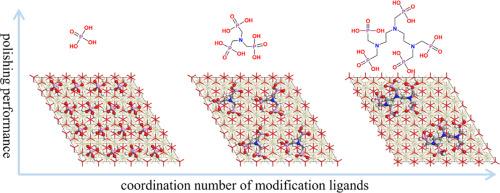化学机械抛光中表面修饰CeO2的配体-性能关系:以配位数为例
IF 6.3
2区 材料科学
Q2 CHEMISTRY, PHYSICAL
引用次数: 0
摘要
在化学机械抛光中,表面改性是调整CeO2颗粒性能的最有效方法之一。虽然大量的研究已经初步证明了配体结构在修饰CeO2的性能中起着重要的作用,但文献中对配体配位数与抛光性能之间的结构-性能关系的基本见解仍然缺乏。通过比较H3PO4、氨基三亚甲基膦酸(ATMP)和二乙烯三氨基膦酸(DTPMP)等配体对CeO2浆料的抛光性能,证明了螯合位点较多的配体具有较好的修饰效果。具体而言,用DTPMP改性的浆料在悬浮稳定性、材料去除率和表面质量方面表现最佳。通过密度泛函理论计算进行的机理研究表明,CeO2表面的配位强度和配体密度都与配位数相关,从而导致所制备的浆料具有明显的性能特征。这项工作不仅阐明了配位数与CeO2浆料抛光性能之间的基本关系,而且为开发化学机械抛光所需的高性能浆料提供了实用的策略。本文章由计算机程序翻译,如有差异,请以英文原文为准。

Ligand-performance relationships of surface-modified CeO2 in chemical mechanical polishing: A case of coordination number
Surface modification represents one of the most effective methods for tailoring the properties of CeO2 particles in chemical mechanical polishing. Although numerous studies have demonstrated preliminary evidence that ligand structure plays an important role in determining the performance of modified CeO2, fundamental insights into the structure-property relationships between ligand coordination number and polishing performance remain lacking in the literature. By comparing the polishing performance of CeO2 slurries modified by a series of phosphorus ligands with varying numbers of coordination sites-including H3PO4, aminotrimethylene phosphonic acid (ATMP), and diethylenetriaminepenta(methylenephosphonic acid) (DTPMP)-we demonstrate that ligands with more chelating sites yield superior modification effects. Specifically, optimal performance in terms of suspension stability, material removal rate, and surface quality was observed for slurries modified with DTPMP. Mechanistic investigation through density functional theory calculations reveals that both the coordination strengths and ligand densities on the CeO2 surface are correlated with their coordination number, which results in distinct performance characteristics of the prepared slurries. This work not only elucidates the fundamental relationships between ligand coordination number and the polishing performance of CeO2 slurries but also provides a practical strategy for developing high-performance slurries required for chemical mechanical polishing.
求助全文
通过发布文献求助,成功后即可免费获取论文全文。
去求助
来源期刊

Surfaces and Interfaces
Chemistry-General Chemistry
CiteScore
8.50
自引率
6.50%
发文量
753
审稿时长
35 days
期刊介绍:
The aim of the journal is to provide a respectful outlet for ''sound science'' papers in all research areas on surfaces and interfaces. We define sound science papers as papers that describe new and well-executed research, but that do not necessarily provide brand new insights or are merely a description of research results.
Surfaces and Interfaces publishes research papers in all fields of surface science which may not always find the right home on first submission to our Elsevier sister journals (Applied Surface, Surface and Coatings Technology, Thin Solid Films)
 求助内容:
求助内容: 应助结果提醒方式:
应助结果提醒方式:


